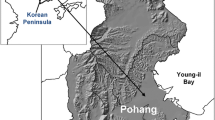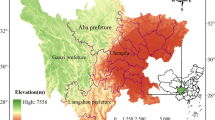Abstract
Land use and landscape changes, which have much effect on local biodiversity, are driven primarily by socioeconomic forces. Understanding these forces is important for preservation of current biodiversity. In this study, we clarified the socioeconomic forces that have brought about changes in the forest landscape around the Ogawa Forest Reserve in the southern Abukuma Mountains, Japan, by interviewing local residents and reviewing local historical documents. Furthermore, we reconstructed past forest landscapes and quantified the changes that have occurred from the beginning of the twentieth century until the present by use of old land-use maps and past aerial photographs. The use of forest resources has dramatically changed during the past hundred years, and it can be divided into three periods corresponding to the level of economic development. The main landscape has changed significantly from one mainly composed of expansive grasslands and broad-leaved forests into a mosaic of fragmented secondary forests and coniferous plantations. These landscape changes reflect shifts in both the use of forest resources by local residents and the management of the national forests. Clarifying temporal–spatial landscape changes by understanding the historical relationship between humans and the landscape provides useful information for optimizing conservation and management planning.







Similar content being viewed by others
References
Antrop M (2005) Why landscapes of the past are important for the future. Landsc Urban Plan 70:21–34
Bičík I, Jeleček L, Štěpánek V (2001) Land-use changes and their social driving forces in Czechia in the 19th and 20th centuries. Land Use Policy 18:65–73
Black AE, Strand E, Wright RG, Scott JM, Morgan P, Watson C (1998) Land use history at multiple scales: implications for conservation planning. Landsc Urban Plan 43:49–63
Cousins SAO, Eriksson O (2002) The influence of management history and habitat on plant species richness in a rural hemiboreal landscape, Sweden. Landsc Ecol 17:517–529
Editorial Committee of Tagakoma shi (1982) Tagakoma shi (History of the horse in the Taga region). Taga Animal Husbandry Agricultural Cooperative, Mito (in Japanese)
Forestry Agency (1948) Fukushima ken Iwaki gun Tabito mura keizai rin jittai tyosa houkoku (Investigation of actual conditions of economic forest in Tabito village). Fukushima prefecture, Iwaki county (in Japanese)
Forestry Agency (1957, 1962) Ringyo tokei youran (Statistical year book for forestry). Japan Forest Foundation, Tokyo (in Japanese)
Forestry Agency (1964) Ringyo roudou no syugyou keitai ni kansuru jittai tyosa-Hukushima ken Iwaki gun Tabito mura oyobi Kawamae mura (Investigation of actual condition concerning form of forest labor-Tabito village and Kawamae village, Iwaki county, Fukusima prefecture) (in Japanese)
Forestry Agency (1967, 1972, 1977, 1982, 1987, 1992, 1997, 2002) Ringyo tokei youran (Statistical year book for forestry). Japan Forest Foundation, Tokyo (in Japanese)
Foster DR (1992) Land-use history (1730–1990) and vegetation dynamics in central New England, USA. J Ecol 80:753–772
Fujihara M, Kikuchi T (2005) Changes in landscape structure of the Nagara River Basin, Central Japan. Landsc Urban Plan 70:271–281
Fujihara M, Hara K, Short KM (2005) Changes in landscape structure of “yatsu” valleys: a typical Japanese urban fringe landscape. Landsc Urban Plan 70:261–270
Fukamachi K, Oku H, Yokohari M (1997) A study on the changing process of satoyama in Kamiseya and Ikega districts, in Kyoto prefecture. J Jpn Inst Landsc Architect 60:521–526 (in Japanese with English Summary)
Fukamachi K, Imoto I, Kuramoto N (1998) New relations between satoyama and people. J Jpn Inst Landsc Architect 61:275 (in Japanese)
Fukamachi K, Oku H, Nakashizuka T (2001) The change of a satoyama landscape and its causality in Kamiseya, Kyoto prefecture, Japan between 1970 and 1995. Landsc Ecol 16:703–717
Gachet S, Leduc A, Bergeron Y, Nguyen TX, Tremblay F (2007) Understory vegetation of boreal tree plantations: difference in relation to previous land use and natural forest. For Ecol Manage 242:49–57
Goto T, Ogasawara A, Hongo T, Ikeguchi H, Takeuchi K (2003) The transitions of land use and biological resources use in Gunnai region, the Eastern Yamanashi. J Jpn Inst Landsc Architect 66:569–572 (in Japanese with English Summary)
Hanawa-machi (ed) (1986) Hanawa machi shi (History of Hanawa town). Hanwa-town, Fukushima (in Japanese)
Himiyama Y (2002) Land-use change and regional development in Hokkaido. In: Himiyama Y, Hwang M, Ichinose T (eds) Land-use changes in comparative perspective. Science Publishers, USA, pp 221–239
Himiyama Y, Hwang M, Ichinose T (2002) Land-use changes in comparative perspective. Science Publishers, USA
Hosoya M (1983) Ibaraki-ken tyoson enkaku shi (History of municipalities in Ibaraki prefecture). Senshusha, Tokyo (in Japanese)
Ibaraki University Association of Sociology Law (1956) Iriaiken no kenkyu dainisyu (Study of common right the second collection). Society of Sociology of Law of Ibaraki University, Mito (in Japanese)
Ichikawa K, Okubo N, Okubo S, Takeuchi K (2006) Transition of the satoyama landscape in the urban fringe of the Tokyo metropolitan area from 1880 to 2001. Landsc Urban Plan 78:398–410
Iwaki-gun County Office (1979) Iwaki gun shi (History of Iwaki county. Rekishitosyosya, Tokyo (in Japanese)
Kamada M, Nakagoshi N (1997) Influence of cultural factors on landscapes of mountainous farm villages in western Japan. Landsc Urban Plan 37:85–90
Kuroda N (2002) Changes in forest uses and their influence on the forest landscape in Shirakawa-mura, Ogimachi. J Jpn Inst Landsc Architect 65:659–664 (in Japanese with English Summary)
Lathrop RG, Tulloch DL, Hatfield C (2007) Consequences of land use change in the New York-New Jersey Highlands, USA: landscape indicators of forest and watershed integrity. Landsc Urban Plan 79:150–159
Marcucci DJ (2000) Landscape history as a planning tool. Landsc Urban Plan 49:67–81
Matsushita B, Xu M, Fukushima T (2006) Characterizing the changes in landscape structure in the Lake Kasumigaura Basin, Japan using a high-quality GIS dataset. Landsc Urban Plan 78:241–250
Ministry of Agriculture, Forestry and Fisheries (1980) Nourin suisan ruinen toukei Ibaraki (Annual statistics for agriculture forestry and fishery of Ibaraki prefecture). National Federation of Agriculture and Forestry Statistics Association, Tokyo (in Japanese)
Mizoguchi Y, Morisawa T, Ohtani Y (2002) Climate in Ogawa Forest Reserve. In: Nakashizuka T, Matsumoto Y (eds) Diversity and interaction in a temperate forest community—Ogawa Forest Reserve of Japan. Springer, Tokyo, pp 11–18
Nagaike T, Kamitani T (1997) Factors affecting changes in landscape structure dominated by both primary and coppice forests in the Fagus crenata forest region of central Japan. J For Res 2:193–198
Nakashizuka T, Matsumoto Y (2002) Diversity and interaction in a temperate forest community—Ogawa Forest Reserve of Japan. Springer, Tokyo
Okubo S, Fukamachi K, Kuramoto N (2000) Toward conservations of rural landscapes. J Jpn Inst Landsc Architect 63:177–207 (in Japanese)
Shimonaka K (1982) Ibaraki-ken no chimei (The place-name of Ibaraki prefecture). Heibonsha, Tokyo (in Japanese)
Suzuki W (2002) Forest vegetation in and around Ogawa Forest Reserve in relation to human impact. In: Nakashizuka T, Matsumoto Y (eds) Diversity and interaction in a temperate forest community—Ogawa Forest Reserve of Japan. Springer, Tokyo, pp 27–41
Tokyo Regional Forest Office (1984) Forth forest regional management plan for Takahagi District National forests (in Japanese)
Wu J, Hobbs R (2002) Key issues and research priorities in landscape ecology: an idiosyncratic synthesis. Landsc Ecol 17:355–365
Wu Q, Li HQ, Wang RS, Paulussen J, He Y, Wang M, Wang BH, Wang Z (2006) Monitoring and predicting land use change in Beijing using remote sensing and GIS. Landsc Urban Plan 78:322–333
Acknowledgments
We would like to thank the Samegawa town office, the Tabito branch office of Iwaki city, and the people of Sadanami and Ogawa for offering useful information, and Dr W. Suzuki for providing old literature on the national forests. We also thank Mr H. Yamagata for assisting with the interview process, and Drs T. Nakashizuka, M. Shibata, M. Ichikawa, K. Akao, W. Hujita, M. Imada, and T. Matsuura for making invaluable suggestions during the course of the study. This research was partly supported by the Research Institute for Humanity and Nature Projects of the Japanese Ministry of Education, Culture, Sports, Science and Technology (P2-2) and by the Global Environment Research Fund (H-081) of the Japanese Ministry of the Environment.
Author information
Authors and Affiliations
Corresponding author
About this article
Cite this article
Miyamoto, A., Sano, M., Tanaka, H. et al. Changes in forest resource utilization and forest landscapes in the southern Abukuma Mountains, Japan during the twentieth century. J For Res 16, 87–97 (2011). https://doi.org/10.1007/s10310-010-0213-x
Received:
Accepted:
Published:
Issue Date:
DOI: https://doi.org/10.1007/s10310-010-0213-x




